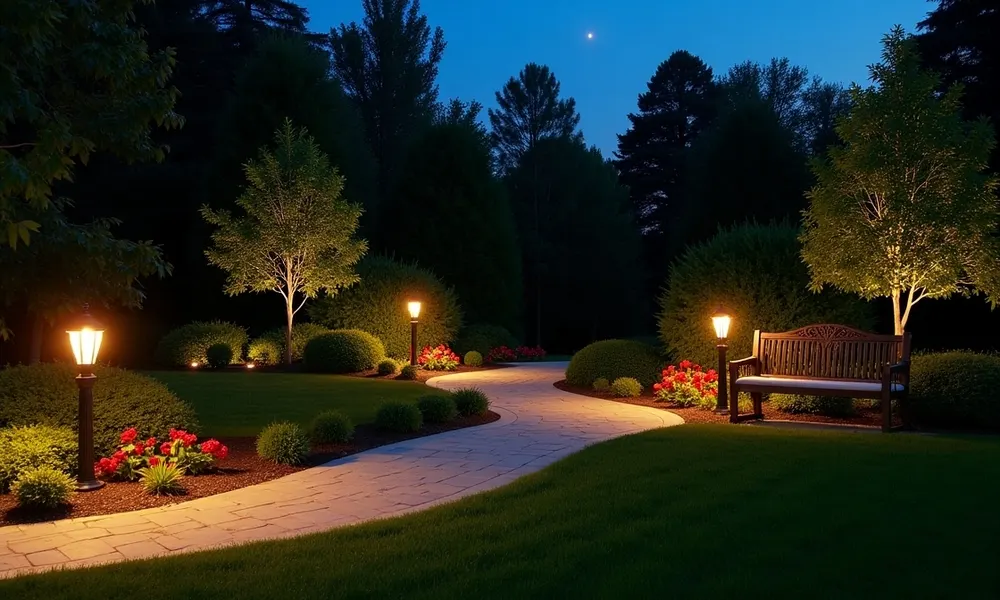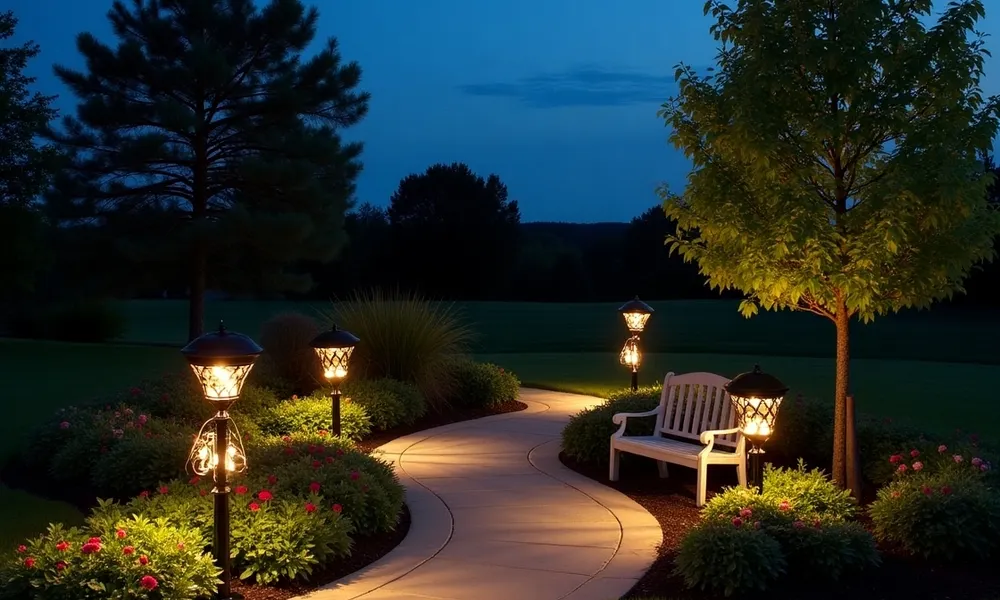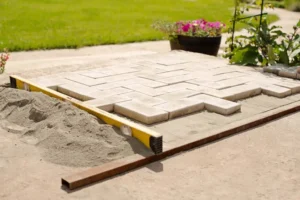How to design landscape lighting starts with understanding how light can enhance your outdoor space’s beauty and functionality. In addition to enhancing safety and visibility, a clever landscape lighting design draws attention to important features like trees, walkways, and architectural components. In addition to improving curb appeal, well-lit spaces foster a friendly atmosphere. A solid landscape lighting design guide helps you choose the right fixtures, placement, and techniques. The advantages include increased outside usability, enhanced security, and superior aesthetics. With thoughtful planning, your landscape can shine both day and night.
Understanding Landscape Lighting

Landscape lighting, also known as outdoor lighting design, involves the strategic placement of light fixtures throughout outdoor spaces such as gardens, walkways, patios, and architectural features. Its goal is to enhance the beauty, safety, and usability of exterior environments after dark.
Purpose of Landscape Lighting
- Aesthetics
A well-planned landscape lighting service highlights key features like trees, fountains, or stone pathways, adding depth and drama to a property. Lighting can create mood, draw attention to focal points, and elevate the overall design of your outdoor space. - Security
Outdoor lighting design also plays a critical role in deterring intruders. Dark corners, driveways, and illuminated entryways make it more difficult for intruders to approach covertly. - Functionality
Lighting extends the usability of outdoor areas after sunset. Whether you’re entertaining on the patio or navigating walkways, landscape lighting ensures visibility and safety for everyone.
Key Components of Landscape Lighting
- Fixtures: These include spotlights, path lights, floodlights, and well lights, each serving a specific function in outdoor lighting design.
- Power Sources: Most systems use low-voltage electricity, though solar-powered options are becoming more popular.
- Transformers: These reduce the typical household voltage to a safer level that is appropriate for outdoor use.
- Wiring: Proper cabling connects fixtures to the transformer and ensures safe, efficient power distribution throughout the system.
Daylight vs. Nighttime Lighting Considerations
- During the Day: Fixtures should blend into the landscape, maintaining the natural aesthetics without standing out or looking obtrusive.
- At Night: Lighting should create balanced illumination, avoiding glare or overly bright spots. A professional landscape lighting service will design with contrasts and shadows in mind to create depth and visual interest.
The Benefits of Landscape Lighting
Adding lights to your yard or garden isn’t just about making things look nice—it also makes your home safer and more useful after dark. A good landscape lighting design brings out the best in your outdoor space, whether it’s your backyard, front lawn, or garden path. Here are some key benefits:
1. Boosts Curb Appeal and Property Value
When your home looks attractive from the outside, it makes a great first impression. Well-placed outdoor lights can highlight your home’s best features and make it stand out at night. A smart landscape lighting design can also increase your property’s value by improving its overall look and feel.
2. Improves Safety and Security
Lighting up walkways, stairs, and entry points helps prevent trips and falls. It also keeps your home safer by making it harder for intruders to hide in the dark. Security and safety lights are frequently included in a well-considered landscape lighting design guide.
3. Makes Outdoor Spaces More Usable
With the right lighting, you can enjoy your patio, deck, or garden even after the sun goes down. Whether you’re having a family dinner or relaxing with friends, outdoor lights help create a cozy and functional atmosphere.
4. Shows Off Natural and Architectural Features
Landscape lighting can draw attention to your favorite parts of the yard, like a big tree, a water feature, or stonework on the house. These elements are beautifully and subtly highlighted by a well-thought-out design plan.
You may plan your lights to best suit your property by using a landscape lighting design guide. With the right setup, you’ll enjoy a more beautiful, safe, and functional outdoor space every night.
The Different Types of Landscape Lighting for Your Property
Choosing the right lights can completely change the look and feel of your outdoor spaces. A well-thought-out landscape lighting design not only adds beauty but also improves safety and function around your home. Consider the following typical varieties of landscape lighting:
1. Path Lighting
These lights are positioned beside garden walks, driveways, and walkways. They help guide people safely at night while adding a charming glow to your landscaping.
2. Accent or Spot Lighting
Want to draw attention to a beautiful tree, statue, or fountain? Spotlights focus a beam of light on specific features to create a dramatic effect and enhance curb appeal.
3. Floodlights
Floodlights provide wide, bright lighting that covers large areas. They’re perfect for illuminating driveways, yards, or the sides of your home—and they help improve nighttime security.
4. Step and Deck Lights
These are built into stairs, decks, or railings to light up walking surfaces. They make moving around safer in the dark and add a stylish touch to outdoor living spaces.
5. Well Lights & In-Ground Lights
Installed flush with the ground, these lights shine upward to highlight trees, walls, or architectural details without showing the fixture. They’re ideal for a sleek, contemporary style.
6. String or Bistro Lights
These hanging lights create a cozy, festive atmosphere—ideal for patios, pergolas, and outdoor gatherings. They’re great for adding soft ambiance and charm.
Whether you want to brighten your walkways or create a relaxing outdoor hangout, a customized landscape lighting design can make all the difference.
You may read about How to Install Landscape Lighting Like a Pro.
7 Easy Steps to Design Landscape Lighting

Creating the perfect outdoor lighting setup doesn’t have to be complicated. With the right approach, you can enhance your home’s beauty, safety, and functionality. Whether you’re a DIY enthusiast or planning to hire a landscape lighting service, these 7 simple steps will guide you through a smart and effective outdoor lighting design.
1. Evaluate Your Space
Start by walking around your yard or garden at night. Look for areas that are too dark, as well as features you’d like to highlight—like trees, pathways, or water features. Noticing how your space feels after dark is key to creating a thoughtful lighting plan.
2. Determine Lighting Goals
Think about what you want your lighting to do. Are you looking to improve safety on stairs and walkways, create a cozy mood, highlight your landscaping for aesthetic appeal, or simply make the space more functional? Your goals will help guide the rest of the process.
3. Sketch a Basic Lighting Plan
Draw a rough layout of your property. Mark where important elements are—like patios, trees, walkways, and driveways—and note where you think lights should go. This step is helpful whether you’re doing it yourself or handing it off to a landscape lighting service.
4. Choose Fixture Types
Select the right lights for each area. For example:
- Path lights for walkways
- Spotlights for trees and statues
- Floodlights for wide-area coverage
- Step lights for stairs and decks
Matching your lighting goals with the correct fixture types is a big part of smart outdoor lighting design.
5. Plan for Power and Wiring
Decide what kind of power system fits your space:
- Low-voltage systems (most common, energy-efficient)
- Solar lights (easy to install, but depend on sun exposure)
- Line-voltage (more powerful, best for large properties—usually needs professional help)
6. Select Bulbs and Light Temperature
Choose between LED (long-lasting and energy-efficient) or halogen bulbs. Think about color temperature too—warm white creates a cozy glow, while cooler white adds a modern, brighter look. Don’t forget to consider brightness (measured in lumens) for each area.
7. Install and Test
Place your lights, run the wiring (if needed), and test everything. Make sure the fixtures are aimed properly and adjust them as needed for the best look and function.
Need Professional Help?
Designing outdoor lighting can be fun, but it also takes time and planning. If you’d rather leave it to the experts, Lakota Design Group offers high-quality landscape lighting service in the Bay Area. We’ll take care of everything—from design to installation—so your outdoor spaces shine just the way you want.
How to Select the Best Wiring Method for Landscape Lighting
Choosing the right wiring method is key to a safe and efficient outdoor lighting design. Here’s a quick guide to help you decide:
Power Options Overview
- Low-Voltage Systems
Most common choice for residential use. Safe, energy-efficient, and easy to install.
Pros: Safer for DIY, energy-saving
Cons: Limited range for large areas - Line-Voltage Systems
Used for bigger properties or commercial setups.
Pros: Powerful, covers large areas
Cons: Requires professional installation, higher cost - Solar Lighting
Simple setup with no wiring.
Pros: Easy to install, eco-friendly
Cons: Less reliable in shaded or cloudy areas, limited brightness
Best Practices for Wiring Layout
- Plan wire paths before digging
- Use waterproof connectors and outdoor-rated cables
- Keep wires at least 6 inches underground
- Avoid running wires near high-traffic or digging areas
Tips for Safe Installation
- Always turn off power before connecting wires
- Use a transformer for low-voltage systems
- Test your setup before final burial
If unsure, consult a professional landscape lighting service
Conclusion
Landscape lighting adds beauty, safety, and functionality to your outdoor space. Key steps include evaluating your property, choosing the right fixtures, and selecting a proper wiring method. The benefits range from better curb appeal to safer walkways and extended evening use. While DIY is possible, hiring a pro ensures a smooth, lasting result. Lakota Design Group offers expert landscape lighting service in the Bay Area. Contact us today to bring your outdoor lighting vision to life.
FAQs
What Is The First Step In Designing Landscape Lighting?
The first step is to evaluate your outdoor space at night to identify key features and dark areas that need lighting.
How Do I Decide Where To Place Lights In My Yard?
Sketch a basic layout of your property and mark important areas like paths, trees, and patios where lighting will improve safety or highlight features.
What Types Of Lights Should I Use For Different Outdoor Areas?
Use path lights for walkways, spotlights for trees or sculptures, floodlights for security, and string lights for patios or entertaining spaces.
Should I Choose Low-Voltage, Solar, Or Line-Voltage Lighting?
Low-voltage is great for most homes due to safety and efficiency, solar is easy to install but less powerful, and line-voltage suits large properties but often requires a professional.
How Do I Ensure My Landscape Lighting Is Energy-Efficient?
Choose LED bulbs and use timers or smart controls to reduce energy consumption while maintaining beautiful lighting.





